Over recent decades vast amounts of biological data have been
accumulated. However, it is becoming increasingly difficult to
apply traditional theoretical methods to the formulation of
coherent pictures of cell and organ function because it is no
longer possible for a human theorist to integrate all of the
available information. Instead, computer technologies must now be
used to perform this integration. This book brings together
contributions from many different fields to summarize the current
status of computer-assisted modelling of biological processes.
The initial chapters deal with fundamental developments in
hardware, software and mathematics that underlie current approaches
to biological modelling. Next, different approaches to collating
data on gene structure and function are presented. These databases
form a vital resource for any investigator trying to construct an
integrated picture of particular biological systems.
Cell signalling systems form a particularly complicated aspect
of all cellular function and are important both in the
understanding of basic cellular processes and in selecting targets
for drugs. Recent approaches to integrating data on cell signalling
into computer models are covered. Further chapters build on these
approaches to show how computerized models of intact cells can be
developed. Finally, approaches to the computer modelling of whole
organs such as the heart are presented. The role of computer
modelling in drug design is the subject of the final chapter and is
also touched on throughout the discussions.
Table des matières
Chair’s Introduction (D. Noble).
Integrative biological modelling in silico (A. Mc Culloch
and G. Huber).
Advances in computing, and their impact on scientific computing
(M. Giles).
From physics to phenomenology: Levels of description and levels
of selection (D. Krakauer).
Making sense of complex phenomena in biology (P. Maini).
On ontologies for biologists: the Gene Ontology–untangling
the web (M. Ashburner and S. Lewis).
General discussion I: Model validation.
The KEGG database (M. Kanehisa).
Shanka Subramaniam and the Bioinformatics Core Laboratory
Bioinformatics of cellular signalling.
General discussion II: Standards of communication.
Semantics and intercommunicability.
Imaging-based integrative models of the heart: closing the loop
between experiment and simulation (R. Winslow, et al.).
General discussion III: Modelling Ca¯2+
signalling.
The Virtual Cell project (L. Loew).
Modelling the bacterial chemotaxis receptor complex (T. Shimizu
and D. Bray).
The heart cell in silico: successes, failures and
prospects (D. Noble).
General discussion IV.
The IUPS Physiome Project (P. Hunter, et al.).
Using in silico biology to facilitate drug development
(J. Levin, et al).
Final discussion: Is there a theoretical biology?
Index of contributors.
Subject index.
A propos de l’auteur
The Novartis Foundation is an international scientific and educational charity which promotes the study and general knowledge of science and in particular encourages international co-operation in scientific research.












